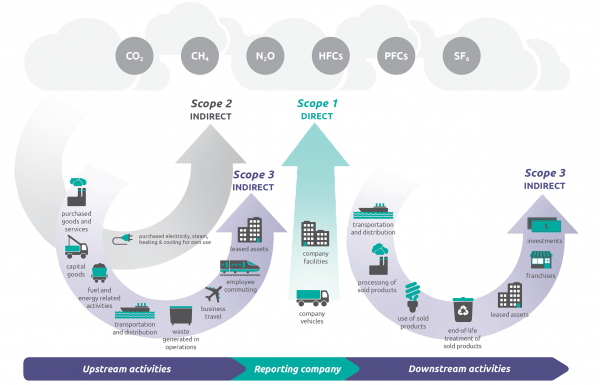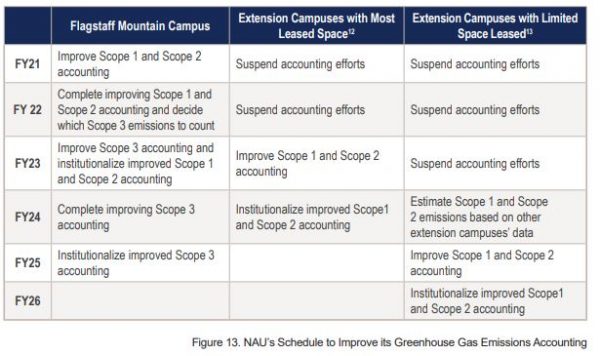Connect With Us...
Carbon Neutrality Action Plan Goals
Greenhouse Gas Accounting and Reporting for Scopes 1-3
Summary of Actions: To make sure NAU can reach carbon neutrality by 2030, we must keep track of GHG emissions in a comprehensive and continuous manner. Some of the data streams we need to establish for that include annual tracking of fleet fuel usage by fuel type (scope 1), annual emissions accounting (micro-fleets: rental, field research, shuttles, facilities & grounds, shuttle; police), quantification of emissions associated with purchased water, commuting, university-sponsored travel, waste and reclaimed water, solid waste, purchased goods and services, and capital goods.
Outcomes Accordion Open
Comprehensive annual quantification of all emissions generated by the University.
Benefits Accordion Closed
Ability to keep track of our progress and communicate that progress to internal and external audiences.
Uncertainties Accordion Closed
Setting up these data streams is a challenging undertaking and will require campuswide commitment and participation.
Future Action Accordion Closed
- Coordination of data reporting with branch campuses
- Annual tracking of fleet fuel usage by fuel type
- Outcome: Develop a baseline and measuring tool for NAU’s fleet
- Intended benefit: Track the progress of emissions to see where improvement is needed
- Annual emissions accounting (micro fleets – rental, field research, shuttles, facilities & grounds, shuttle; police)
- Quantification of emissions associated with purchased water
- Outcome: Estimate of a portion of Scope 3, category 1 emissions (related to specific purchased good/service)
- Benefit: Ability to monitor the effectiveness of the behavior-based program and inform adjustments needed for the program
- Survey of student; staff; and faculty commuting patterns
- Benefit: Tracking the emissions-intensive scope 3 categories of commuting behavior will be pivotal in transparent and all-encompassing emissions quantification
- Emissions Quantification – tracking commuter emissions over time by type of commuter
- In progress: Surveys of student, faculty, and staff commuting patterns and habits
- Emissions Quantification – tracking business travel over time by type of travel (business, athletic, CIE, etc.)
- Quantify the emissions associated with wastewater, reclaimed water, and solid waste
- Identification of most emission-intensive goods and services purchased
- Engagement with suppliers to reduce most emission-intensive goods/services, targeting sustainable supply chain engagement, restructuring contracts to eliminate single-use plastics
- Benefit: Potential to reduce emissions across the value chain
- Develop and implement a dashboard of annual emissions for transparency and accountability
- Develop a metering plan for existing and new buildings. Install building-level metering where missing.
- Outcome: Benchmarking & Informed Decision Making
Accounting and Methodology Accordion Closed
The process of developing this plan revealed the need to institutionalize a standard approach to greenhouse gas emissions accounting and to collecting and interpreting data. In generating the NAU 2021 CAP, the university established the following standards for future greenhouse gas emissions inventories:
- Operational control approach where the entity accounts for 100% of greenhouse gas emissions from operations that it controls. It considers control to rest with its full power to introduce and execute operating policies and procedures.
- This best addresses the complexity of NAU ownership and space use. NAU operates in 21 locations across the state and its space used as a lessor and as a lessee accounts for over 3 million square feet. The majority of NAU’s space use at its extended campuses is under the ownership and control of other entities.
- Using this approach, some of NAU’s Scope 1 and Scope 2 greenhouse gas emissions will be accounted as Scope 3 emissions by associated entities. For example, at the Flagstaff Mountain Campus, the American Campus Communities (ACC) (housing for which the utility use is a combination of university supplied and other and varies by building), food service operations, and Drury Inn (the on-campus hotel) should report their use of NAU’s utilities as Scope 3 emissions.
- NAU will make all reasonable efforts to track its greenhouse gas emissions by employing temporal adjustments to the greenhouse gas emissions rates associated with university activity as they are available.
Student Projects Accordion Closed
Undergraduate Symposium Submission, 2020 – Holly McEnaney – CEFNS
Title:
Molecular Dynamics Investigation of Ionic Liquids as a Material for Selective Capture and Recycling of Fluorinated Greenhouse Gases
Abstract:
Ionic liquids containing fluorine have shown selective sorption of fluorinated gases that are dangerous greenhouse gas contributors due to their chemical stability. While they only make up about 3% of greenhouse gas emissions, some can remain in the atmosphere for up to 50,000 years. All emissions of fluorinated gases are human-caused, making a method of recovery and recycling important for understanding the environmental impact and curbing the repercussions of modern actions. In this stage of the research project, various fluorine-containing cations and anions are being investigated. Molecular dynamics are used to study the behavior of these ionic liquids both in bulk simulations, representative of a liquid, and interface simulations, allowing equilibrium between liquid and gas phases of the ionic liquid. Density profiles and radial distribution functions are being used to study the interfacial behaviors and chemistry at equilibrium that can be applied to understanding how the system could interact with potential fluorinated greenhouse gases. Most ionic liquids and fluorinated greenhouse gases are dangerous and expensive to synthesize, store, and handle in a traditional lab setting, therefore, computational techniques are advantageous for examining several ionic liquid systems safely. Future work would include optimizing the cation and anion used in the ionic liquid and studying how each system interacts with fluorinated greenhouse gases.
Understanding Emissions and Scopes Accordion Closed
According to the EPA, understanding Scope 1, 2, and 3 greenhouse gas emissions is essential for efforts of decarbonization.
Scope 1 emissions are direct greenhouse emissions that occur from sources that are controlled or owned by an organization. For example, emissions associated with fuel combustion in boilers, furnaces, and vehicles.
Scope 2 emissions are indirect greenhouse emissions associated with the purchase of electricity, steam, heat, or cooling. Although scope 2 emissions physically occur at the facility where they are generated, they are accounted for in an organization’s GHG inventory because they are a result of the organization’s energy use.
Scope 3 emissions are the result of activities from assets not owned or controlled by the reporting organization, but that the organization indirectly affects in its value chain. Scope 3 emissions include all sources not within an organization’s scope 1 and 2 boundaries and often represent the majority of an organization’s total greenhouse gas emissions.

